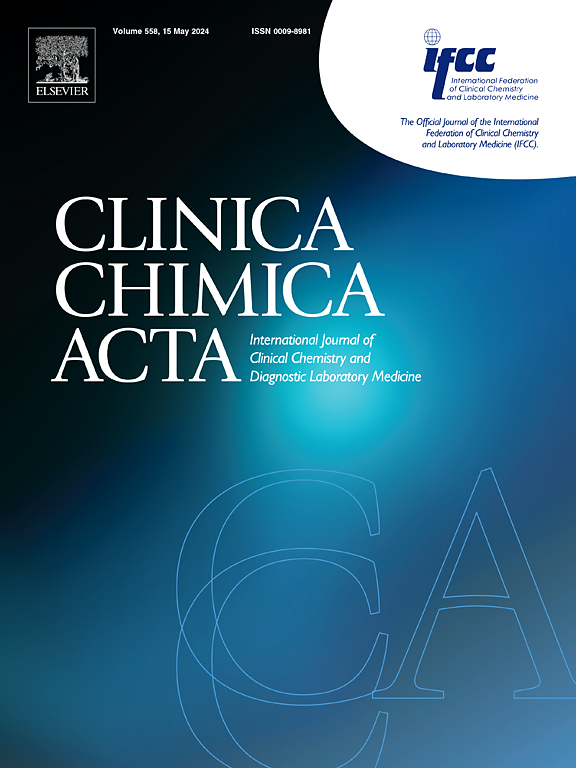Genomic and clinical characterization of carbapenem-resistant Citrobacter freundii isolates in a tertiary hospital (2013–2021)
IF 2.9
3区 医学
Q2 MEDICAL LABORATORY TECHNOLOGY
引用次数: 0
Abstract
Background
The emergence of carbapenem-resistant Citrobacter freundii (CRCF) poses a significant threat to public health, particularly among high-risk populations.
Objective
To characterize the genomic epidemiology of CRCF and analyse the clinical features and risk factor associated with CRCF acquisition.
Methods
A total of 21 CRCF strains were collected from Nanjing Drum Tower Hospital from 2012 to 2021. Following whole genome sequencing and assembly, the distribution of drug resistance genes, mobile genetic element, plasmid replicons as well as sequence type (ST) was analysed. Clinical data were collected from patients isolated with CRCF and CSCF to explore potential risk factors for CRCF acquisition.
Results
Among the 21 CRCF strains, blaNDM-1 (n = 18, 85.7 %) was the most common ARGs, followed by sul1 (n = 17, 80.9 %). Diverse STs were found and the most common ST type was ST17 (n = 4, 19.0 %) and ST396 (n = 3, 14.3 %). Among the 21plasmid replicons, IncX3 (n = 11, 52.4 %) was the most prevalent. Sixteen Insertion sequences (ISs) and 3 transposons (Tns) were identified, and IS6100 (n = 17, 81.0 %) were the most frequent. Co-occurrence of mph(A) and IS6100 were observed in fifteen C. freundii. Of the 21 patients with CRCF infection/colonization, the median age was 62.7 years (19–88 years), of which 17 (80.9 %) were male, 11 (52.4 %) were elderly patients (>65 years), 17 (80.9 %) were hospitalized for more than 10 days. In addition, hypertension (n = 12, 57.1 %) was the main underlying diseases. Risk factor analysis showed that invasive procedures (P = 0.032) was an independent risk factor for CRCF acquisition.
Conclusion
Our study showed that blaNDM-1 was the main gene conferring resistance to carbapenem. Multiple STs identified in the 21 strains showed a genetic diversity of CRCF. Existence of kinds of ISs and Tns among these strains indicated the key role played by these mobile genetic elements. CRCF infection/colonization mainly happened in male elderly patients with the hypertension being the main underlying diseases. Avoiding invasive procedures may be helpful in decreasing the CRCF acquisition.
2013-2021年某三级医院耐碳青霉烯类弗氏柠檬酸杆菌基因组学及临床特征分析
耐碳青霉烯的弗伦地柠檬酸杆菌(CRCF)的出现对公众健康构成了重大威胁,特别是在高危人群中。目的了解CRCF的基因组流行病学特征,分析CRCF发生的临床特点及相关危险因素。方法2012 - 2021年在南京市鼓楼医院采集CRCF株21株。通过全基因组测序和组装,分析了耐药基因、移动遗传元件、质粒复制子和序列类型(ST)的分布。收集分离的CRCF和CSCF患者的临床资料,探讨获得CRCF的潜在危险因素。结果21株CRCF菌株中最常见的ARGs为blaNDM-1 (n = 18, 85.7%),其次为sul1 (n = 17, 80.9%)。ST17 (n = 4, 19.0%)和ST396 (n = 3, 14.3%)是最常见的ST型。在21个质粒复制子中,IncX3 (n = 11, 52.4%)最多。共鉴定出16个插入序列(ISs)和3个转座子(Tns),其中以IS6100 (n = 17, 81.0%)最为常见。在15只弗氏弓形虫中观察到mph(A)和IS6100的共存。21例CRCF感染/定植患者中位年龄为62.7岁(19 ~ 88岁),其中男性17例(80.9%),老年患者11例(52.4%)(65岁),住院10天以上17例(80.9%)。此外,高血压(n = 12, 57.1%)是主要的基础疾病。危险因素分析显示,有创手术(P = 0.032)是CRCF获得的独立危险因素。结论blaNDM-1基因是碳青霉烯类耐药的主要基因。在21个菌株中鉴定的多个STs显示了CRCF的遗传多样性。在这些菌株中存在多种ISs和Tns,表明这些移动遗传元件发挥了关键作用。CRCF感染/定植主要发生在老年男性患者中,以高血压为主要基础疾病。避免侵入性手术可能有助于减少CRCF的发生。
本文章由计算机程序翻译,如有差异,请以英文原文为准。
求助全文
约1分钟内获得全文
求助全文
来源期刊

Clinica Chimica Acta
医学-医学实验技术
CiteScore
10.10
自引率
2.00%
发文量
1268
审稿时长
23 days
期刊介绍:
The Official Journal of the International Federation of Clinical Chemistry and Laboratory Medicine (IFCC)
Clinica Chimica Acta is a high-quality journal which publishes original Research Communications in the field of clinical chemistry and laboratory medicine, defined as the diagnostic application of chemistry, biochemistry, immunochemistry, biochemical aspects of hematology, toxicology, and molecular biology to the study of human disease in body fluids and cells.
The objective of the journal is to publish novel information leading to a better understanding of biological mechanisms of human diseases, their prevention, diagnosis, and patient management. Reports of an applied clinical character are also welcome. Papers concerned with normal metabolic processes or with constituents of normal cells or body fluids, such as reports of experimental or clinical studies in animals, are only considered when they are clearly and directly relevant to human disease. Evaluation of commercial products have a low priority for publication, unless they are novel or represent a technological breakthrough. Studies dealing with effects of drugs and natural products and studies dealing with the redox status in various diseases are not within the journal''s scope. Development and evaluation of novel analytical methodologies where applicable to diagnostic clinical chemistry and laboratory medicine, including point-of-care testing, and topics on laboratory management and informatics will also be considered. Studies focused on emerging diagnostic technologies and (big) data analysis procedures including digitalization, mobile Health, and artificial Intelligence applied to Laboratory Medicine are also of interest.
 求助内容:
求助内容: 应助结果提醒方式:
应助结果提醒方式:


